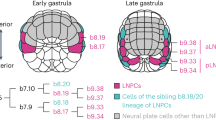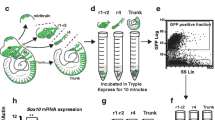Abstract
Reciprocal interactions between epithelial and neural crest-derived mesenchymal cells have been recognized in the evolutionary modulation of tetrapod odontodes, skeletal structures that include the teeth and tooth-integrated basal tissue. Using cell-tracking experiments, it has been demonstrated that mandibular neural crest cells, labelled during migration, extensively populate dental papillae of all tooth phenotypes of the lobe-finned fish, the Australian lungfish (Neoceratodus forsteri). Here, I report on an extension of this experimental study that earliest migrating NC cells are able to differentiate into odontogenic ectomesenchyme. Using vital dye cell-tracking to mark the mesencephalic neural crest prior to migration, I have found that the corresponding population of earliest migratory cells selectively relocated to dental papillae of both temporary and permanent dentitions of Neoceratodus. I noticed a gradient in distribution of the labelled cells which populated posterior teeth, pterygoid and prearticular (including associated trabecular and Meckelian cartilages; major relocation) much more densely than those in anterior marginal positions, temporary and vomeral permanent teeth (minor relocation). Contrary to mice and zebrafish, the odontogenic potency of mesencephalic neural crest cells is already programmed at the onset of the migration event in lungfish. This may imply that the morphogenic potential of mesencephalic neural crest cells to form teeth has been heterochronically shifted and constrained to later migratory populations of neural crest cells during the developmental evolution of derived tetrapods, or/and arrested in their expression in the oral development of some modern osteichthyans.




Similar content being viewed by others
Data availability
All images documenting the experiment are housed at the Center for Interdisciplinary Biosciences of the Pavol Jozef Šafárik University in Košice, Slovak Republic.
Code availability
Not applicable.
References
Ahlberg PE (1991) A re-examination of sarcopterygian interrelationships, with special reference to the Porolepiformes. Zool J Linn Soc London 10(3):241–287. https://onlinelibrary.wiley.com/doi/abs/10.1111/j.1096-3642.1991.tb00905.x. Accessed 2021
Brinkmann H, Venkatesh B, Brenner S, Meyer A (2004) Nuclear protein-coding genes support lungfish and not the coelacanth as the closest living relatives of land vertebrates. Proc Natl Acad Sci USA 101:4900–4905. https://www.pnas.org/content/101/14/4900. Accessed 2021
Chai Y, Jiang X, Ito Y, Bringas P, Han J, Rowitch DH, Soriano P, McMahon AP, Sucov HM (2000) Fate of the mammalian cranial neural crest during tooth and mandibular morphogenesis. Development 127:1671–1679. https://dev.biologists.org/content/127/8/1671. Accessed 2021
Chibon P (1967) Experimental study on the origin of teeth in the amphibian urodele Pleurodeles waltli Michah. Arch Oral Biol 12:745–753. https://pubmed.ncbi.nlm.nih.gov/5229328/. Accessed 2021
Eberhart JK, Swartz ME, Crump JG, Kimmel CB (2006) Early Hedgehog signaling from neural to oral epithelium organizes anterior craniofacial development. Development 133(6):1069–1077. https://journals.biologists.com/dev/article/133/6/1069/43516/Early-Hedgehog-signaling-from-neural-to-oral. Accessed 2021
Falck P, Joss J, Olsson L (2000) Cranial neural crest cell migration in the Australian lungfish, Neoceratodus forsteri. Evol Dev 4:179–185. https://pubmed.ncbi.nlm.nih.gov/11252560/. Accessed 2021
Graveson AC, Smith MM, Hall BK (1997) Neural crest potential for tooth development in a urodele amphibian: developmental and evolutionary significance. Dev Biol 188:34–42. https://pubmed.ncbi.nlm.nih.gov/9245509/. Accessed 2021
Imai H, Osumi-Yamashita N, Ninomiya Y, Eto K (1996) Contribution of early-emigrating midbrain crest cells to the dental mesenchyme of mandibular molar teeth in rat embryo. Dev Biol 176:151–165. https://pubmed.ncbi.nlm.nih.gov/8660858/. Accessed 2021
Jackman WR, Stock DW (2006) Transgenic analysis of Dlx regulation in fish tooth development reveals evolutionary retention of enhancer function despite organ loss. Proc Nat Acad Sci USA 103:19390–19395. https://www.ncbi.nlm.nih.gov/pmc/articles/PMC1748236/. Accessed 2021
Jackman WR, Draper BW, Stock DW (2004) Fgf signaling is required for zebrafish tooth development. Dev Biol 274:139–157. https://www.sciencedirect.com/science/article/pii/S0012160604004634. Accessed 2021
Jernval J, Thesleff I (2000) Reiterative signaling and patterning during mammalian tooth morphogenesis. Mech Dev 92:19–29. https://www.sciencedirect.com/science/article/pii/S0925477399003226. Accessed 2021
Kemp A (1977) The pattern of tooth plate formation in the Australian lungfish, Neoceratodus forsteri Krefft. Zool J Linn Soc London 60(3):223–258. https://doi.org/10.1111/j.1096-3642.1977.tb01028.x
Kemp A (1982) The embryological development of the Queensland lungfish, Neoceratodus forsteri (Krefft). Mem Queensland Mus 20:553–597
Kemp A (2002) Unique dentition in lungfish. Microsc Res Tech 59:435–448. https://onlinelibrary.wiley.com/doi/abs/10.1002/jemt.10221. Accessed 2021
Kemp A (2006) The marginal dentition of the Australian lungfish, Neoceratodus forsteri (Osteichthyes: Dipnoi). J Zool 257(3):325–331. https://doi.org/10.1017/S0952836902000924
Kollar EJ (1986) Tissue interactions in development of teeth and related ectodermal derivatives. Dev Biol 4:297–313. https://pubmed.ncbi.nlm.nih.gov/3078134/. Accessed 2021
Kundrát M, Joss JMP, Smith MM (2008) Fate mapping in embryos of Neoceratodus forsteri reveals cranial neural crest participation in tooth developmental as conserved from lungfish to tetrapods. Evol Dev 10:531–536. https://onlinelibrary.wiley.com/doi/abs/10.1111/j.1525-142X.2008.00268.x. Accessed 2021
Lumsden AG (1988) Spatial organization of the epithelium and the role of neural crest cells in the initiation of the mammalian tooth germ. Development 103:155–169. https://pubmed.ncbi.nlm.nih.gov/3250849/. Accessed 2021
Meyer A, Wilson AC (1990) Origin of tetrapods inferred from their mitochondrial DNA affiliation of lungfish. J Mol Evol 31:359–364. https://link.springer.com/article/10.1007/BF02106050. Accessed 2021
Meyer A, Schloissnig S, Franchini P, Du K, Woltering JM, Irisarri I, Wong WY, Nowoshilow S, Kneitz S, Kawaguchi A, Fabritzius A, Xiong P, Dechaud C, Spaink HP, Volff J-N, Simakov O, Burmester T, Tanaka EM, Schartl M (2021) Giant lungfish genome elucidates the conquest of land by vertebrates. Nature 590:284–289. https://www.nature.com/articles/s41586-021-03198-8. Accessed 2021
Mina M, Kollar EJ (1987) The induction of odontogenesis in non-dental mesenchyme combined with early murine mandibular arch epithelium. Arch Oral Biol 32:123–127. https://pubmed.ncbi.nlm.nih.gov/3478009/. Accessed 2021
Reisz RR, Smith MM (2001) Lungfish dental pattern conserved for 360 Myr. Nature 411:548. https://www.nature.com/articles/35079187. Accessed 2021
Rothová M, Peterková R, Tucker AS (2012) Fate map of the dental mesenchyme: dynamic development of the dental papilla and folicle. Dev Biol 366:244–254. https://www.sciencedirect.com/science/article/pii/S0012160612001832?via%3Dihub. Accessed 2021
Schultze HP (1969) Die Faltenzähne der rhipidistiden Crossopterygier, der Tetrapoden und der Actinopterygier-Gattung Lepisosteus, nebst einer Beschreibung der Zahnstruktur von Onychodus (struniiformer Crossopterygier). Palaeontogr Ital 65:1–137
Serbedzija GN, Bronner-Fraser M, Fraser SE (1992) Vital dye analysis of cranial neural crest cell migration in the mouse embryo. Development 116:297–307. https://dev.biologists.org/content/116/2/297. Accessed 2021
Sharpe PT (2001) Neural crest and tooth morphogenesis. Adv Dent Res 15:4–7. https://pubmed.ncbi.nlm.nih.gov/12640730/. Accessed 2021
Smith MM, Krupina NI, Joss J (2002) Developmental constraints conserve evolutionary pattern in an osteichthyan dentition. Connect Tissue Res 43(2–3):113–119. https://pubmed.ncbi.nlm.nih.gov/12489146/. Accessed 2021
Smith MM, Okabe M, Joss J (2009) Spatial and temporal pattern for the dentition in the Australian lungfish revealed with sonic hedgehog expression profile. Proc Biol Sci 276(1657):623–631. https://www.ncbi.nlm.nih.gov/pmc/articles/PMC2660947/. Accessed 2021
Wagner G (1955) Chimaerische Zahnlagen aus Triton-Schmelzorgan und Bombinator-Papille. Miy Beobachtungen über die Entwicklung von Kiemenzahnchen und Mundsinnesknospen in den Triton-Larven. J Embryol Exp Morphol 3:160–188. https://link.springer.com/article/10.1007/BF00576376. Accessed 2021
Zhang Y, Wang S, Song Y, Han J, Chai Y, Chen YP (2003) Timing of odontogenic neural crest cell migration and tooth-forming capability in mice. Dev Dyn 226:713–718. https://pubmed.ncbi.nlm.nih.gov/12666208/. Accessed 2021
Zhu N, Yu X (2002) A primitive fish close to the common ancestor for tetrapods and lungfish. Nature 418:767–770. https://www.nature.com/articles/nature00871. Accessed 2021
Acknowledgements
I thank Prof. Jean Joss for her support of my experimentation using lungfish embryos, Debra Birch for her assistance with the confocal microscope and Libby Eyre for collection of lungfish eggs. I also thank the anonymous reviewers for their helpful comments and suggestions on an earlier version of this article. I am grateful to Janet Ahlberg, a professional editor and translator, for her kind help with improving the grammar of the revised manuscript. Finally, I would like to thank to my family for support and to dedicate this article in honor of my father.
Funding
This project was supported by a Macquarie University Research Development grant, the project “Open scientific community for modern interdisciplinary research in medicine” (OPENMED), ITMS2014 + : 313011V455, supported by the Operational Programme Integrated Infrastructure, funded by the European Regional Development Fund, and by the Slovak Research and Development Agency (APVV-18–0251).
Author information
Authors and Affiliations
Contributions
M.K. designed the study, carried out experiments and wrote the paper.
Corresponding author
Ethics declarations
Ethics approval
All experimental procedures were conducted according to protocols approved by Macquarie University´s Animal Ethics Committee (AEC approval # 2003–001).
Conflict of interest
The author declares no competing interests.
Additional information
Communicated by: Robert Reisz
Publisher's note
Springer Nature remains neutral with regard to jurisdictional claims in published maps and institutional affiliations.
Rights and permissions
About this article
Cite this article
Kundrát, M. Earliest migratory cephalic NC cells are potent to differentiate into dental ectomesenchyme of the two lungfish dentitions: tetrapodomorph ancestral condition of unconstrained capability of mesencephalic NC cells to form oral teeth. Sci Nat 108, 37 (2021). https://doi.org/10.1007/s00114-021-01750-0
Received:
Revised:
Accepted:
Published:
DOI: https://doi.org/10.1007/s00114-021-01750-0




